Part II: Instant Checkout Deep Dive: Let's Get Nerdy! 🤓
In this post we get a little nerdier than usual and look at the specifications for ChatGPT's new Product Feed, Instant Checkout and how it all comes together in ACP.
Welcome to Part II of our three part Deep Dive on ChatGPT Instant Checkout. Here’s where we are in this series:
Part I - User Experience, Merchant (DTC Brand or Retailer) Experience and what does this mean for Merchants (you, most of my readers) and Agentic Commerce strategically?
YOU ARE HERE——» Part II - Let’s get nerdy and dig into the feed and ACP specs to understand more.
Part III - Open questions, what the naysayers are saying, and FAQs we are hearing from merchants with answers where available.
Why is this Important?
On Monday September 29th, ChatGPT announced ChatGPT Instant Checkout which is an event that we believe will change the course of e-commerce. Perplexity introduced us to the amazing combination of GenAI LLMs married with web search called an ‘answer engine’ and they also innovated with ‘Buy on Pro’, showing us that the magic continues when you marry an answer engine with shopping and agents - Agentic Commerce was born! ChatGPT has rapidly caught up to those innovations releasing web search 10/31/24, just a year ago, and over that year has built improved commerce research, find and now buy functionality with the introduction of the checkout. Answer engines are now becoming Agentic Commerce marketplaces.
This is a rapidly moving market and we believe by this time next year we will have 6-8 tech giants battling it out for the Merchant’s inventory and the consumer’s share of wallet.
Topics
In this post we’ll get one or two levels more technical, but not down to the code/spec level. If you’ve been in digital retail for 3-5 years that’s our sweet spot. We’re not going to explain basics like ‘what is a checkout is or a product catalog feed’, but we’re also not going to show you some API function calls. Most people in digital retail have spent at least 40hrs in a giant spreadsheet of product data and inventory, so we’ll assume (somewhat painful) familiarity with that.
That being said, our mission is to help everyone learn about this, so if we introduce a concept here you don’t know about - there’s no such thing as a dumb question in this fast-moving new world. Also, if you or someone on your technical team wants to go deeper, we’re happy to do that more 1:1. The best path to those is reach out through the substack or hop on the chat→
We’re going to peel into this topic like an onion getting closer to the code a we go:
When a feed is not a feed!!
Components of the ChatGPT Instant Checkout System and how they interact
Feeds, crawlers and training
ChatGPT Product Feed Deep Dive
ChatGPT ACP - how it all orchestrates together
When a Feed is not a Feed (what?)
🚨Alert🚨: ChatGPT Feeds are not ‘normal’ (aka Legacy) feeds!!
This is so critical that I want to specifically call it out first and separately before we get into it. I have talked to many retailers and brands that are on the verge of making a huge mistake. They saw the word ‘feed’ in the ChatGPT announcement and they are basically reformatting their Google Shopping feed to send to ChatGPT.
If I can achieve one thing with this post, it is to warn you:
DO NOT SEND A SIMPLE GOOGLE SHOPPING FEED TO CHATGPT!!!
How the ChatGPT Feed is Different…
The way we are thinking about it is Legacy feeds are two-dimensional and ChatGPT is fifteen-dimensional. It’s 7X more complex and intricate. While you can send a 2D Feed to a 15D system, you are missing 13 dimensions of data that will 100% be used by the underlying GenAI LLM system to surface your product. You have basically raised a white flag and surrendered the sale to another merchant that didn’t take the easy way and did the work.
More detail on this in the Feed section, but you’ll notice that there are sections for performance signals, compliance, Reviews and Q+A (that can be very large), related products and geo tagging. This isn’t your typical feed folks!
Why? CONTENT+CONTEXT
Why does ChatGPT want all of this information? This is at the core of the whole reason we’re so excited about this new opportunity - it’s not only a new way to research, find and buy products, it’s BETTER.
Google and everything prior to 2022 is designed off keywords. When you have a keyword based world, you want less data, to minimize keyword spam. Correspondingly, all of our pre-2022 ecommerce infrastructure is very fragile. The search is easily broken or returns no results or wildly wrong. You want less data vs. more.
With the introduction of LLMs, that all changes and this is a perfect little window into that. The engines want ALL THE CONTENT. On top of that they want CONTEXT.
This is how they make a better buyer experience - we’ll talk more about that in Part III when we pull this all together.
For now, promise me, please please please do not take your google shopping feed and convert it to this format and send that. 😱😱😱
Components of the ChatGPT Instant Checkout System
There are three components that work in concert to implement the ChatGPT Instant Checkout System.
The Product Feed - This component provides a direct path to get your product and inventory data information directly into ChatGPT.
Agentic Checkout - The Agentic Checkout sits between the buyer, ChatGPT, the merchant and the payment system and coordinates all the state changes, and information exchanges that happen in a checkout system. The Checkout system acts as the customer’s AI agent, rendering the user interface and manages the complete user experience within ChatGPT’s UI.
Delegated Payment - Underneath the Checkout, there is a Delegated Payment system that takes all the order information the payment system needs, delivers that payload to the Merchant’s payment service provider (PSP), who then processes it using Stripe’s Shared Payment Token. Stripe is the first company to implement this Delegated Payment Spec and OpenAI hints that more are coming soon.
The Specs
For my fellow Nerds/Retailgeeks out there, let’s dig in. First we can’t go further on a topic like this without some specs (short for specifications), let’s spec it up!
The ChatGPT Product Feed Spec is here.
The Agentic Checkout Spec is here.
The Delegated Payment Spec is here. (This is out of scope for our audience, so we won’t be saying more beyond this about us, but if you want to get REALLY nerdy…. Party on Garth!”
In addition to the Specs, OpenAI also has a three very handy Guides:
The Getting Started Guide is here
The Key Concepts Guide is here
The Production Readiness Guide is here (don’t underestimate the importance of this one!)
Flexibility of the Components
The first signal we got that this system was unusual is in the signup form (here if you missed it in part I) that had these four checkboxes I wanted to call out:
Historically in e-commerce, you have two distinct and mutually exclusive mechanisms for promoting your product catalog off-site:
Feed based - The only real remaining comparison-shopping engine left is Google Shopping, but in their heyday, there were 10-15 active Comparison Shopping Engines (CSEs) that were all feed-based. Most affiliate systems are also feed based still as well. 99.9% of retailers generate feeds for Google Shopping/Adwords and Bing and deliver those to their merchant centers.
API / (full-stack) - If you want to work with a marketplace like eBay, Amazon, Walmart, Target, or the hundreds of marketplaces, or you if you want to sell via shop-able ads or a social marketplace like TikTok Shop, you use an API approach. I call it full-stack as you send the inventory data and the order/checkout information via one API.
When you read through ACP Spec, you realize, it’s not just the form - the way ChatGPT has implemented this gives the Merchant three options and feeds are not mutually exclusive with the checkout, nor do you have to do both:
Do nothing - Always an option plus if you block ChatGPTs crawlers, you won’t have any of your product data, reviews or Q+A in the ChatGPT indexes at all. (Amazon is here).
ChatGPT Feed only - Maybe you decide that the full ChatGPT Checkout is not for you for a variety of reasons, but you love free traffic (who doesn’t) - you can just send a Feed. According to ChatGPT this will not change your ranking*
ChatGPT Feed and Agentic Checkout - If you want to participate in the ChatGPT Checkout system, you need to use both the ChatGPT Feed and the Agentic Checkout components. Note: There’s no scenario where you have the Agentic Checkout and NOT the ChatGPT Feed.
* This is true, BUT over-time, data shows us that consumes love convenience and as they get familiar with ChatGPT Checkout, I bet the ‘visit’ button gets less conversions down-stream than the ‘Buy’ button up-stream, but something is always > nothing!
To illustrate, I threw together what a badge-like carousel would look like - You’d be more likely (assume the products are the same which they aren’t - squint), to save time and buy one of the first two, not the third option.
Training data, Crawlers, Agents and Feeds
As I talk to various people in a Retailer or Brand’s organization, I’ve realized that all of this data slinging around is somewhat confusing. Here’s a diagram I’ve been using to help explain it as simply as possible.
In this diagram on the left we have the Merchant. This Merchant sells something direct-to-consumer on their site. That site is powered by a system of some kind (either commercially available or DIY) that inside of it has your product catalog which is needed to generate PDPs, etc. That product catalog is in a database on a server, most likely in the cloud, but could be on-premise too. I’ve called that ‘Merchant Server’ for simplicity.
Over on the right we have a shopper that wants to buy things. That buyer could go directly to your website, but in this example, they are using ChatGPT to shop.
All of the stuff between the right and left are the various systems that ChatGPT has to access your data - largely the Product Catalog, and present it to that buyer.
There are three main data paths:
Training Data - Using Web Data Extraction/Crawlers - ChatGPT has a database of every piece of text it can find on the internet and everywhere else to train their models. ChatGPT’s training data stops in June of 2024 - they are surely training a new model (ChatGPT 6? 7?) on new data today that we’ll see in 12-18 months.
Web Search Index - Because training data is instantly ‘stale’, to augment that data, ChatGPT is constantly building a Google-like web search index. When products are detected, they are flagged as such (this is me making an educated guess) and sent to a giant MEGA product catalog
ChatGPT Feed - Now instead of crawling your site for data you can voluntarily transmit the product catalog data server-to-server. Plus having a specification makes it clear what information on the product-detail-page ‘matters’ and is used by ChatGPT vs. having to guess.
This combination of data sources allows ChatGPT Shopping and ChatGPT Checkout to offer the three scenarios I mentioned above and it can be helpful to keep this framework in mind as we talk about all these different pieces of data.
What’s awesome about finally having a feed is the web data extraction process is fragile and results in lots of little errors being introduced into the process that pile up to erode the experience. Some of these we have documented on retailgentic such as Part 2 of our ‘GEO for Retailers and Brands’ three-part series, we paused to jump into this ChatGPT three-part series.🤯.
In addition to better control and knowledge of the data transmitted, this system gives the merchant control over the frequency. Before the ChatGPT feed system, maybe you are in fashion and launch your Fall line up of 800 new products. Now you have to wait patiently for GPTBot or BingBot, etc. to swing by and notice you have all this awesome new product catalog to consume. If you implement the ChatGPT feed system, you can control what you send and when. You can even turn on or off two fields (enable_search and enable_checkout) as you see fit→
To their credit, OpenAI truly has implemented the most merchant-friendly experience with ACP that I have seen in 30 years of doing this and I think this is incredibly smart and well thought out - this is no accident, this is 100% strategic (more on that in Part 3).
🤔What’s not clear at all is if you choose to send a ChatGPT Feed, does that over-write or replace the existing crawler-based data ChatGPT has in it’s system, or do they merge it together in someway? Based on what we’ve seen, we’re guessing ‘merge’, but it’s very early.
ChatGPT Product Feed Deep Dive
We’re getting deep enough now that we’re close to just walking through the spec which is boring. So I’ll hit some highlights for business folks and then talk about the differences in more detail which I think, as mentioned at the top, are super-important to understand and get your head around. We’re working in a totally new paradigm now.
Key Takeaways from the ChatGPT Product Feed
You can update product data as frequently as 15mins
This system is designed to take in millions of SKUs, it is built to be very very scalable
Freshness matters - ChatGPT is hinting they want up-to-date inventory and price inventory. I imagine ultimately repeat offenders will be somehow demoted.
The ‘Production readiness’ guide gives business people and your dev teams a useful checklist and I believe transparency into how ChatGPT is going to test your feed and checkout integrations before you go live - pay very close attention to this guide.
Have I mentioned you should NOT just dust off your Google Shopping feed and send that?
Strategic Differences between a Legacy Feed and ChatGPT Feed
Here we’ve gone through the biggest differences we see between what you used to call feeds (Legacy feeds) and the ChatGPT Product Feed:
Size and Structure
Legacy Feed → Row for every SKU, the columns are various fields for that SKU - such as price, quantity available, and usually a minimum number of 5-10 attributes.
ChatGPT Feed →A row for each product (SKU), the columns are product data but go well beyond the basics of each item to include things like product specific reviews and Q&A
End-Use Context
Legacy Feed → Optimized for structured ads in Google Shopping and Merchant Center.
ChatGPT Feed → Optimized for conversational discovery and agentic shopping engines where users “ask” about products rather than browse listings.
Granularity
Legacy Feed → Primarily child-level (SKUs) with item_group_id to connect parent/child.
ChatGPT → Flexible: accepts parent-level entries with curated child variants (default: up to 3 representative variants per product).
Data Model
Legacy Feed → Fixed schema with mandatory fields (id, title, price, availability, link, image, etc.).
ChatGPT → JSON-first schema designed for LLM readability, with fields grouped into core product data, custom attributes, and semantic enrichment.
Attributes
Legacy Feed → Very commerce-centric: price, GTIN, MPN, brand, condition, shipping, tax.
ChatGPT → Broader semantic attributes: natural-language description, features, use_cases, benefits, plus optional structured attributes like materials, sizing, sustainability.
Customization
Legacy Feed → Rigid field requirements; minimal flexibility beyond custom labels.
ChatGPT → Allows custom fields and semantic attributes, giving brands more freedom to describe differentiators.
Enrichment
Google → Merchants enrich feeds manually
ChatGPT → Designed for AI enrichment—merchants can submit raw but well-structured data, which LLMs interpret and expand.
How the Components Orchestrate: ACP
Finally, how does all this work together? Here I’m going to reference a diagram from one of ChatGPT’s guides which does a great job of illustrating the role of the four participants in this Purchase Orchestra and the sequence and states a ‘happy order’ goes through:
Throughout here, ChatGPT has done a great job of identifying, anticipating and handling many of the common problems (out of stock, card fail, etc.) that can happen to any transaction that I’ve seen folks like Google, Twitter, Insta/FB/Meta not implement in their attempts at e-commerce.
How do I implement ChatGPT Checkout for my systems?
This is a hard question because the answer is: it depends on your systems. If you are on a modern, hosted/cloud-based ecommerce platform, I imagine, that like Shopify, they will all eventually add support. I doubt anyone but Shopify will make Holiday 2025. There are ways to accelerate this if you want to. If you have implemented a marketplace or have an Order API or ability to receive a pre-paid order, those end-points can help.
I’m happy to help you think through it - reach out and we’ll discuss.
That’s a wrap, coming up in Part III.
That concludes our fun nerdy deep dive! Hopefully you now have a much deeper understanding of the components of the ChatGPT Instant Checkout, understand each of them in detail, grok how all the data flows together, and finally how the components fit together to create an exciting new way for consumers to buy from you in the most merchant-friendly way we have seen.
In Part III, we’ll put a bow on this Deep Dive with some open unknown questions, a point/counter-point of what the naysayers are saying and as questions have come in we DO know the answers to, we’re collecting them and will round them all up. Do you have questions? Let us know in comments, chat or DM me!
Happy Agentic Commercing!😉



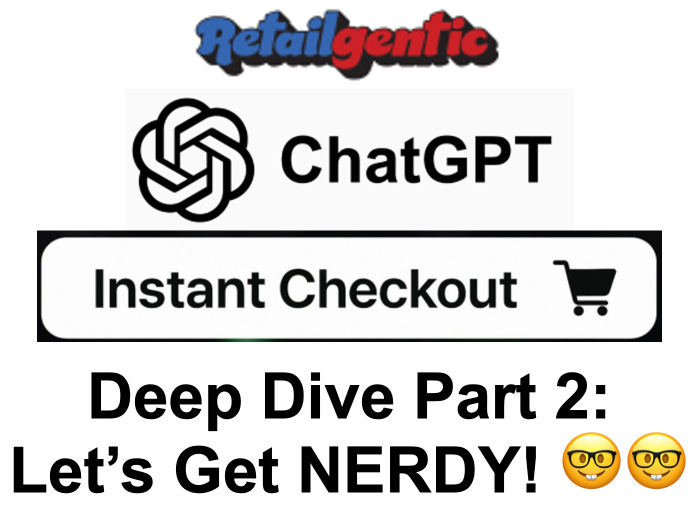

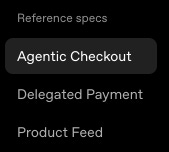



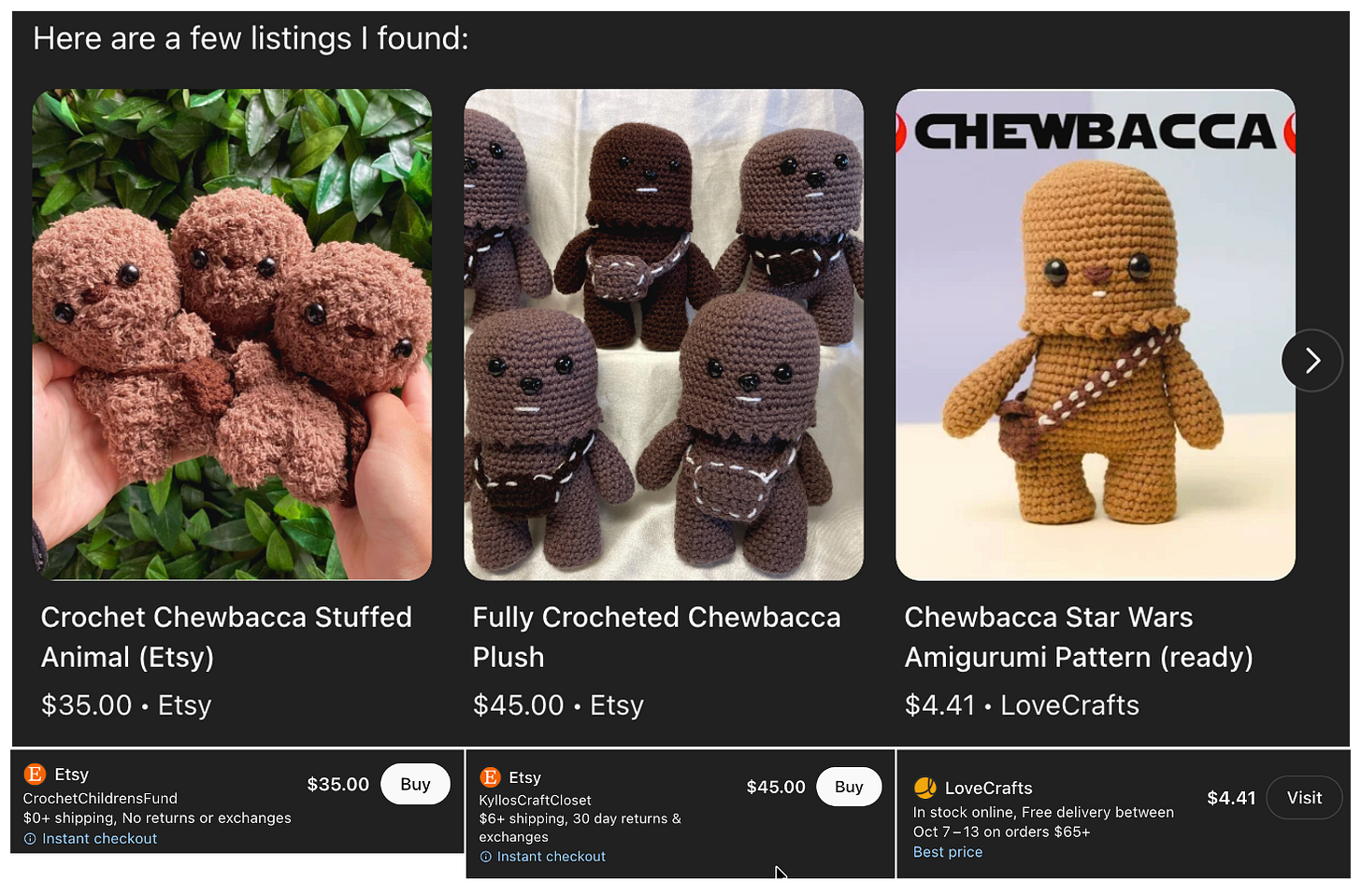
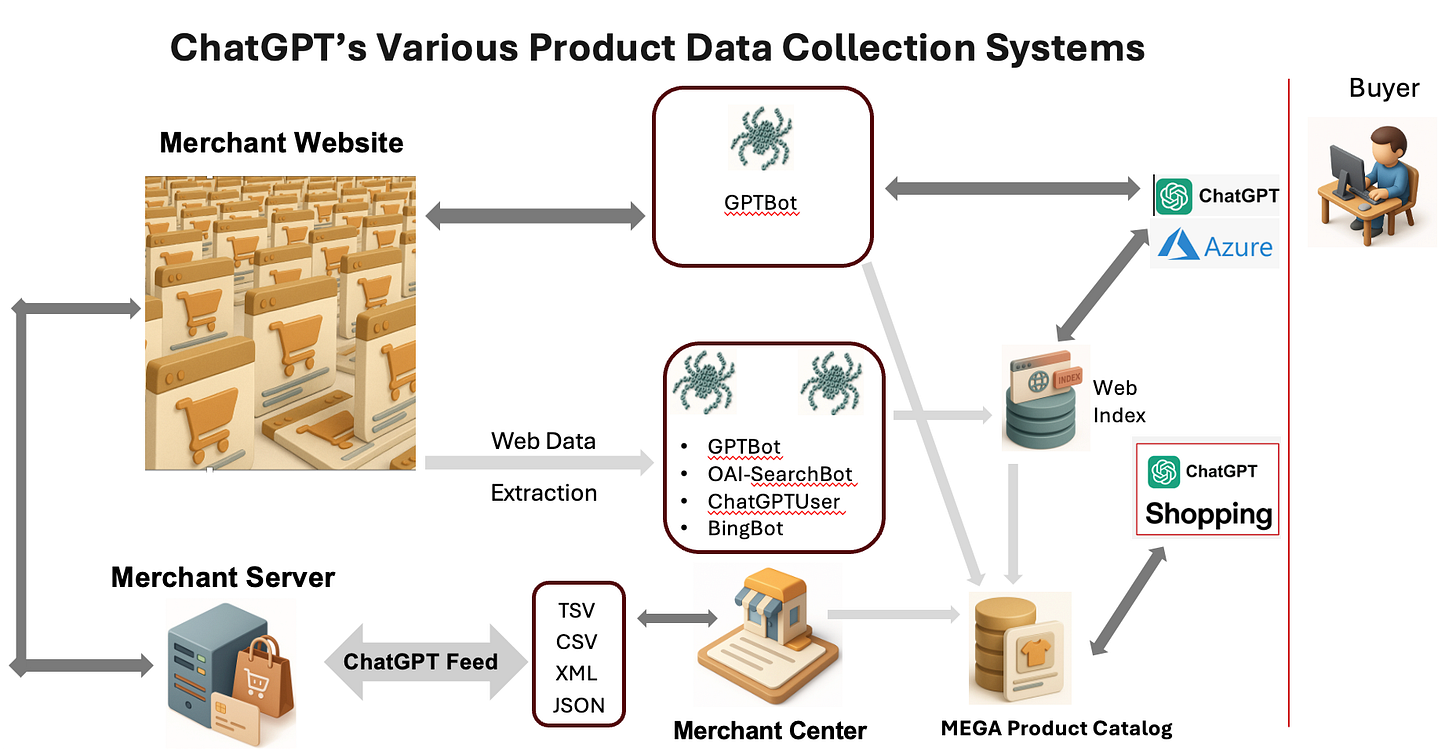
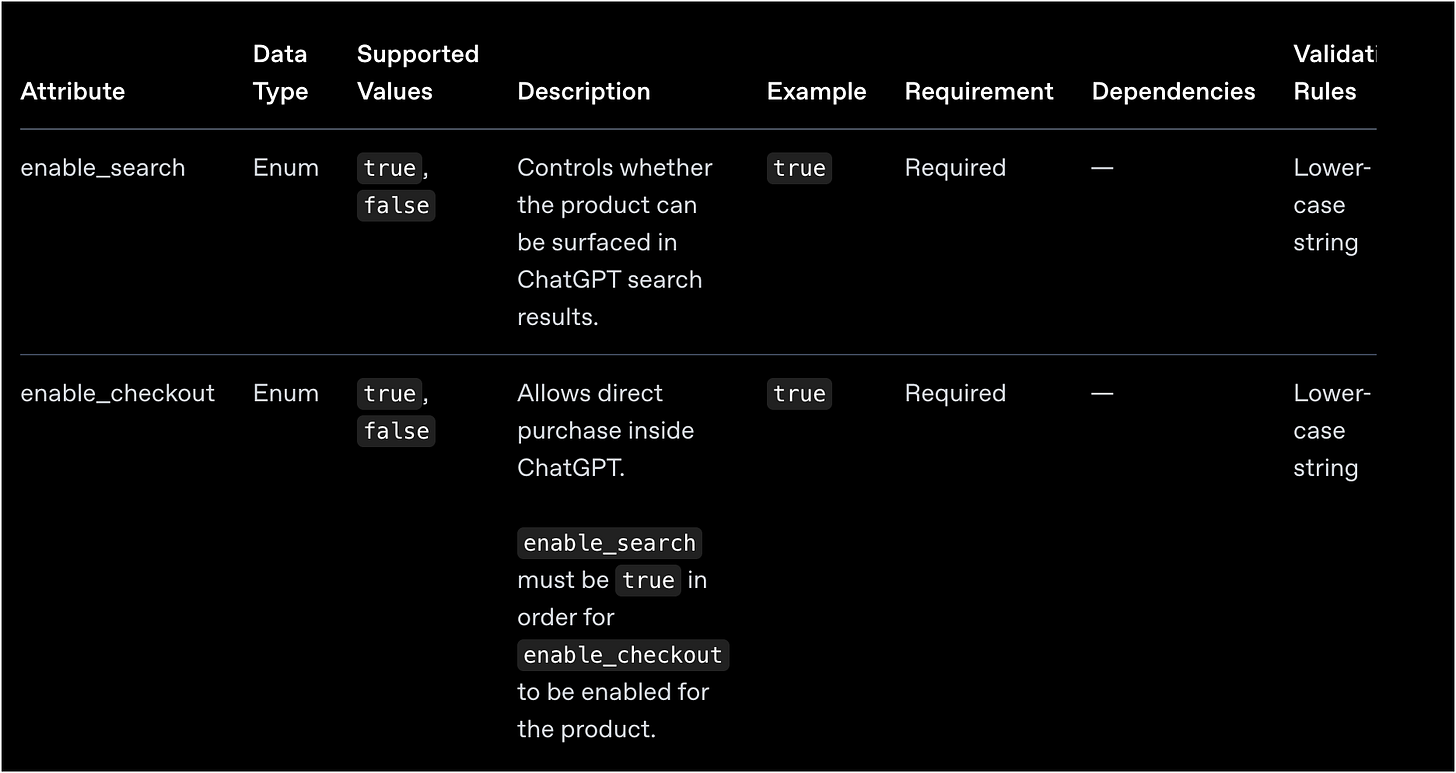
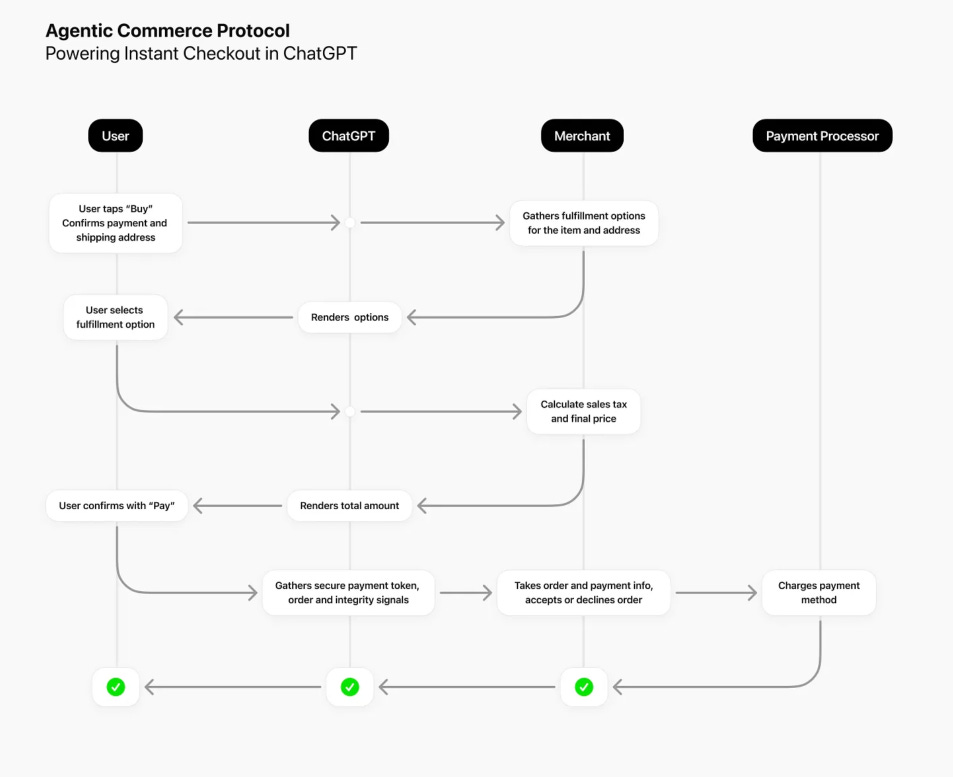
Amazing content, so happy to have discovered your substack some months ago, it's the best source to stay ahead about agentic commerce.
Thanks for putting in the work and sharing in record time this easy to digest, rich and actionable version of of ACP specs. Really appreciate it !
Thank you for putting this all together! Using the resources you shared here, I'm building out a 15-dimensional product feed for a client now ;)
Also requested a demo of https://www.refibuy.ai as your offering there looks super promising.
Cheers!